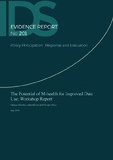| dc.contributor.author | Munslow, T | |
| dc.contributor.author | Barnett, I | |
| dc.contributor.author | Dewi, D | |
| dc.coverage.spatial | Indonesia | en |
| dc.date.accessioned | 2016-07-27T11:59:42Z | |
| dc.date.available | 2016-07-27T11:59:42Z | |
| dc.date.issued | 2016-07 | |
| dc.identifier.citation | Munslow, T.; Barnett, I. and Dewi, D. (2016) The Potential of M-health for Improved Data Use: Workshop Report, IDS Evidence Report 201, Brighton: IDS | en |
| dc.identifier.uri | https://opendocs.ids.ac.uk/opendocs/handle/20.500.12413/12124 | |
| dc.description.abstract | The Institute of Development Studies (IDS), in partnership with World Vision Indonesia, are exploring whether a recently implemented nutrition surveillance intervention, known as M-health, is being used to improve community-based data collection on nutrition. The M-health mobile phone application has been integrated into the Indonesian national nutrition service delivery through the community-based health service called ‘posyandu’. Established in 1986, the posyandu is Indonesia’s main national community nutrition programme. It functions at the village level, enabling communities to access primary health care.
The aim of the intervention is to reduce maternal, infant and child (under five) mortality rates. The posyandu involves five priority programmes: maternal and child health, which includes the ‘weighing post’ (growth monitoring); family planning; immunisation; nutrition, which includes nutrition counselling; and diarrhoea prevention and treatment. The programme works by the mobile phone application (M-health) automatically sending a referral to health workers at the sub-district-level in cases where a child does not meet the required growth targets. The application also provides the health community-based cadres with reminders and steps to accurately plan follow-up visits. These data are then sent to the community health centres at the sub-district-level, known in Indonesia as the puskesmas.
In the period 2013–15, researchers at IDS worked with World Vision Indonesia to assess whether data produced through mobile phone technology might trigger faster response by nutrition stakeholders. This short report supports ongoing work and focuses on how posyandu-level data might be used by different stakeholders. | en |
| dc.language.iso | en | en |
| dc.publisher | IDS | en |
| dc.relation.ispartofseries | IDS Evidence Report;201 | |
| dc.rights.uri | http://creativecommons.org/licenses/by/3.0/ | en |
| dc.subject | Children and Youth | en |
| dc.subject | Nutrition | en |
| dc.subject | Technology | en |
| dc.title | The Potential of M-health for Improved Data Use: Workshop Report | en |
| dc.type | IDS Evidence Report | en |
| dc.rights.holder | IDS | en |
| dc.identifier.ag | OT/11009/7/3/4/335 | |
| rioxxterms.funder | Default funder | en |
| rioxxterms.version | VoR | en |


